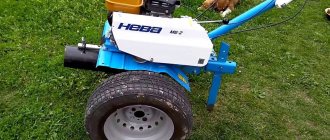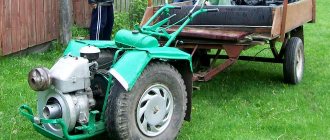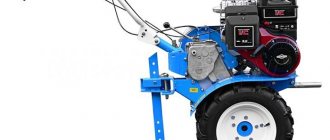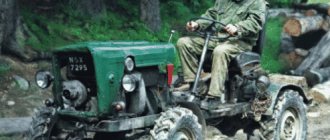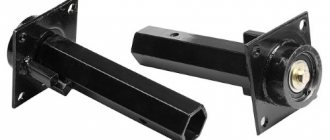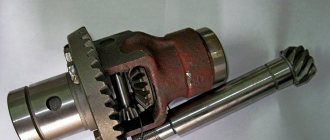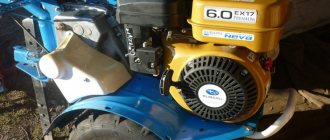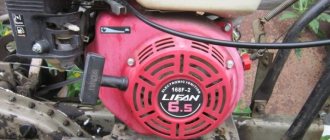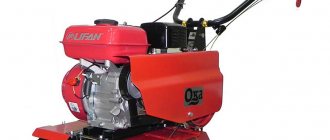Very often in agriculture, serious problems arise when moving equipment. Wheels for the cultivator make it easy to deliver this unit to any part of the garden. Today the market offers a huge selection of wheels. However, it is possible to make them yourself without spending a lot of money.
Wheels for walk-behind tractor: how to choose and how much they cost
Well, let's say you have a walk-behind tractor. By itself it is just a pile of useless metal. In order for it to be useful to you, you also need to purchase a canopy for it, which you can look for in a store, or you can make it yourself. On our website you will find any information about such homemade products.
Attachments will not work properly if your unit has bad wheels - they must fit your walk-behind tractor. Basically, there are two main types of wheels for walk-behind tractors. These are rubber wheels that are equipped with deep treads for driving on dirt roads, as well as metal wheels with lugs for high-quality work in field conditions.
Rubber wheels usually come with the purchase of the walk-behind tractor itself. Problems may arise if you want to change them to others and buy wheels that are not suitable for your unit. You should probably know that not all types of wheels are suitable for field use.
You buy a walk-behind tractor to get the most out of it. This is not a cultivator that you will only use to loosen the soil. The walk-behind tractor must plow the land, plant a crop in it, cultivate what was planted until a certain time, and then harvest the crop. Where a regular wheel cannot handle, a wheel with hooks can easily go.
How to choose rubber wheels
But more about them later. First, if you decide to choose additional tires in the store, consider what purposes they will serve. Always buy wide wheels for tilling the soil. The same ones are needed when digging up planted potatoes. Choose wheels with a diameter of 400 mm and no less. They should be 200 mm wide. Wheels are important when planting potatoes or vegetables in the ground.
It is important to maintain distance between rows here. It should be from 50 to 70 cm so as not to interfere with the passage of the walk-behind tractor, taking into account the standard arrangement of the wheels. To process the sown crop, narrower wheels are needed that do not jam the planting when driving. You want to get rid of the weeds, not the planting. Nowadays, pneumatic tires are in fashion, costing somewhere between 100-130 dollars.
Let's show you some options.
For example, universal wheels, which can be mounted on walk-behind tractors of all brands and models, can also be mounted on motor cultivators and trailers. It’s better to buy these, because you don’t want to pay twice if you get another unit and these tires won’t fit there. There are tube-type wheels with sizes 4.0-10 inches. You can buy them for an average of $90 and get free bolts for attaching them to a walk-behind tractor, tubes for them, rims and tires.
If you have a ZIRKA walk-behind tractor, look at wheels special for this brand with a diameter of 4.0-8 inches. Manufacturers painted them in the company's army khaki color. Just like the previous version, they are chambered, and the kit includes tires, wheels and bolts for fastening to the walk-behind tractor.
Then you need to buy the hubs yourself - they are different for each ZIRKA model. You will not attach these wheels to any other walk-behind tractor, but they will be quite effective on the heavy ZIRKA Lx4061G and Lx4062G models. With simpler equipment they will plow even better. Just like the previous option, they are easily passable on asphalt, on hard ground, and on loose, plowed soil. Rubber wheels for ZIRKA cost about $60.
Another option is tube wheels measuring 5.0-12 inches. You can get them automatically as a set if you buy an Aurora, Centaur, or Bison walk-behind tractor. If you have one of these brands, you can save and change the wheels to another. By the way, they also fit perfectly onto the already mentioned ZIRKA. These wheels engage with walk-behind tractors that weigh at least 9 kg. They will be good when driving on asphalt or on a dirt road. In stores you can buy devices for $120.
In addition to those described, you can find wheels with sizes of 6.0-12 inches. But they are used only with heavy equipment. Such wheels are included when purchased with walk-behind tractors Zubr, Centaur, Zirka, Dobrynya, Aurora, Forte. All these walk-behind tractors weigh at least 8 kg and have a water cooling system. If you buy tires of this type, you will receive bolts for fastening to the unit, disks, ramps and tubes. In addition to walk-behind tractors, you can use wheels on small trailers for them. On the market, wheels for heavy motor blocks cost about $130-140.
How to choose lug wheels for a walk-behind tractor
Another type of wheels for a walk-behind tractor with lugs. You can make these yourself if you wish. You can also buy factory ones in the store. They cost about 80-85 dollars on the market. Their essence is steel teeth, which are placed on the rim of the wheel and bite into the soil that you are processing.
For better results, another tooth is placed on top of the tooth to make the whole thing longer and more effective. Thus, they provide better soil cultivation. If you want to make high-quality harrows, put them on instead of the usual rubber ones and go ahead!
Procedure
Once a suitable drawing (component layout diagram) has been selected, the necessary tools have been found and the Druzhba saw has been dismantled, you can begin assembly. You should start with the frame, since all the elements of the motor unit will be attached to it. The process is completed by assembling the chassis, as well as additional blocks: if desired, headlights, gearbox and clutch, if the drawing is more complex and requires them. For the first time, it is best to choose a simpler drawing.
Frame assembly
The first stage involves the following actions:
- bend the pipe so that it takes the shape of 2 spars with edges pointing upward;
- the steering wheel is welded at the back (the easiest way is to weld two handles, but if available, you can use a ready-made steering wheel from a motorcycle);
- It is recommended to strengthen the structure with cross members from the same pipe;
- We cut out a “shelf” from a metal sheet for the battery, which we weld to the rear bends of the side members.
It turns out to be a vague resemblance to a sleigh. For heavier structures with more powerful power units, the frame can be made in the shape of a cube or similar to a tractor for 4-wheeled homemade products.
Assembly of the motor block
The most difficult stage is assembling the components. Before you begin, you need to mark on the frame the places to which the parts will be attached. The principle is as follows:
- a motor with a gearbox is mounted on top of the crossbars;
- a fuel tank is installed under the engine (a separate support should be welded under it), the battery is mounted on a special platform;
- To prevent exhaust gases from entering the control unit, you can make an exhaust pipe from a 7 cm metal tube with a diameter of up to 25 cm.
This is the basic version without a gearbox, which can be installed upon request. The drawings will help you understand the assembly in more detail. By and large, the details of “Friendship” are simply rearranged. The hitch is connected to the output shaft of the chainsaw.
Chassis assembly
There are at least two options: you can use a ready-made axle shaft from a car, or you can make a homemade walk-behind tractor driven by physical force (the “chassis” of an old cart or wheelbarrow will come in handy, which will significantly reduce the weight and dimensions, because a car axle shaft will require the use of tires). In the first case, you will have to organize the drive from the motor to the axle shaft, which is not easy, so welding the “running” wheelbarrow to the frame is a more understandable option.
It is not difficult to figure out how to make a walk-behind tractor from a chainsaw if you understand the general operating principle of both units. In addition to “Friendship”, “Ural” and “Taiga” saws are also suitable for the walk-behind tractor. When deciding to experiment, you should understand that the homemade product will have limited functionality and low power, allowing you to process a maximum of 20 acres.
If you find an error, please select a piece of text and press Ctrl+Enter.
The walk-behind tractor is an effective assistant in the processes of cultivating the land, as well as further caring for the garden and garden. The easiest way to obtain this device is, of course, to purchase it. However, there is an option for making it using a chainsaw engine, in particular from the Soviet “Druzhba”. Its powerful engine, simple design and overall unpretentiousness make it well suited for this role.
How to make wheels for a walk-behind tractor with your own hands
Some DIYers try, for reasons best known to them, to make wheels for a walk-behind tractor with their own hands, rather than buy them in a store. How to make rubber wheels for a walk-behind tractor? No way. They are taken from other equipment, where the wheels are sized for use with a walk-behind tractor. You can take wheels from old Zhiguli cars; for a walk-behind tractor, they are also suitable from a motorized stroller.
Choose the right hub and go!
Principle of operation
The principle of operation, as well as the design of the jack, is quite simple:
- Place the jack in front (the side opposite to the walk-behind tractor levers).
- Adjust the corners of the brackets so that they fit into the gaps on the wheel axles.
- The jack's axle rests on the ground, and the handle rests down to the ground until the walk-behind tractor is fixed to the jack by its weight.
- The locking pins are pulled out and the wheels can be removed.
- After replacing the wheels, to remove the walk-behind tractor from the jack, just pull the handle up and after the walk-behind tractor is in place, you can remove the jack.
When working with a jack for a walk-behind tractor, there is a danger, so follow the rules and safety precautions
When the jack lifts:
- initial force on the handle up;
- when the brackets are vertically upward, there is no force on the handle;
- at the last moment the force vector is directed downward. If you don't hold on to the very end, the handle will pinch your fingers.
When the jack is lowered:
- initially the force presses down;
- when the brackets are vertically upward there is no force on the handle;
- when you continue to lift further, the force vector begins to press upward and if you do not hold the handle and lean over it, it may hit.
This stand for a walk-behind tractor is easy to make; you just need welding and a grinder, and you can make it with your own hands in an hour:
Types of wheels for walk-behind tractors
The walk-behind tractor is a multifunctional agricultural machinery. For high performance, all parts and systems must be in good working order. Otherwise, the technology will not cope with the assigned tasks. A special role in this regard is given to equipped wheels.
Depending on the design characteristics, wheels on a walk-behind tractor are divided into the following types:
- traction;
- supporting;
- solid rubber;
- metal type with lugs;
- paired.
Each type of wheel allows you to solve different problems. By using special components, you can significantly increase the performance of a walk-behind tractor and make it as stable as possible.
Traction wheels
Pneumatic wheels are unique in their design and have a unique tread pattern. It is thanks to him that traction wheels have a second name - “herringbone”.
These are wide elements that provide comfortable movement on flat roads and sticky wet soil.
Parameters of pneumatic wheels:
- width more than 20 centimeters;
- diameter up to 40 centimeters.
Thanks to these data, the wheels are suitable for plowing large plots of land.
Solid wheels
The wheels from the walk-behind tractor are solid rubber with an aggressive tread pattern. This feature allows them to be installed also on mini-tractors.
Due to their fairly large size, these wheels are most often used in difficult terrain, wooded and mountainous areas.
Metal wheels with lugs
This type of wheel is quite small in size. But the power and endurance of the unit is ensured by the presence of weighting materials.
The design also includes steel teeth. Their task is to push the walk-behind tractor forward, preventing slipping even in the smallest area.
Support wheel
Most modern walk-behind tractor models are equipped with one support wheel. It bears the entire load from the engine and other mechanisms that are located in the front part of the motorcycle.
With the help of this support wheel, the endurance of the walk-behind tractor increases and its performance characteristics are optimized.
Twin wheels
These wheels have two parts, they have the same dimensions and shapes. Thanks to their design, they provide excellent maneuverability of the walk-behind tractor on uneven surfaces and significantly increase its speed on a flat road.
With such wheels, slipping is practically eliminated. That's why they are often installed during winter.
ICE-based technology
Homemade products with installed internal combustion engines have greater power and functionality compared to their electric counterparts. This allows you to significantly expand the scope of their use. Attachments in the form of a plow, flat cutter, cultivator, rake are easily mounted on the frame bracket. The unit can also be easily transformed into a roller skating rink or a home mini-tractor.
Having asked the question “how to make a homemade walk-behind tractor,” first of all you need to understand its structure. To assemble a homemade motor cultivator with your own hands, you first need an engine, transmission and reduction gearbox.
For assembly work, you will need a standard set of tools: a set of wrenches, a drill, an angle grinder, a welding machine, and when assembling more complex and load-lifting machines, also turning and milling of some components.
https://youtube.com/watch?v=1KWv0b94BIc
Chainsaw cultivator
Perhaps the best option when making a homemade motor cultivator is to use a chainsaw engine to create it. The advantages here are the performance and power of the unit, undemanding fuel requirements, light weight and compactness. And there won’t be any particular difficulties with the components when assembling it. Everything you need can be found at the car market or flea markets.
General diagram of the walk-behind tractor:
- the walk-behind tractor frame is made in the form of a diamond from a metal corner measuring 3200x3200x3200 mm;
- the engine is mounted on the cross members from above, the gas tank, as a rule, is mounted slightly below;
- the intermediate shaft supports are attached to the front struts;
- The running shaft supports are installed on the longitudinal ribs
To regulate the speed, the original gearbox is used; motorcycle sprockets (main and intermediate) are also used, the number of teeth of which is selected taking into account the required power output. The working tools of the unit are made in the form of wheels with knives and can perform the function of a trimmer, a rotary cutter or a rotary hoe.
As an alternative, you can use the engine from a lawn mower, which is similar in its characteristics to the drive of a chain saw.
https://youtube.com/watch?v=4fNotMF_J_4
Motoblock from a motorcycle
Often, old motorcycles can rust for years in garages and sheds, but they can easily find a second life. Motorcycle engines are great for creating a DIY power tiller, but the most commonly used engines are two-stroke engines from older models, as well as from scooters. But recently, motors from scooters or mopeds have also begun to be actively used, giving broken equipment a second life through conversion.
There are several types of transmission:
- gear - the most common and easy to install;
- combined (gear-worm gear);
- chain-belt, toothed;
- hydraulic gearbox is a type of transmission that is gaining popularity, but is the most expensive compared to a mechanical one.
Possible schemes
A frame of the required size is welded from a corner, to which an engine with a fuel supply system and a gas tank is attached. The transmission of torque from the gearbox, which reduces the speed, to the wheels is carried out through a chain. In this case, you can use a bridge from a donor motorcycle mounted on a wheel axle. All controls are transferred to the steering wheel of the unit.
When designing heavier equipment, a standard ZID-5 engine or its other modifications are used, which were previously widely used on various units. It is paired with a Zaporozhets gearbox and a lightweight drive axle.
Wheel extensions for walk-behind tractor
Axle extensions for walk-behind tractors allow you to expand the wheelbase. With the help of such a part, the unit becomes more stable, regardless of the track width.
Extension cords may be needed to implement the following tasks:
- performing heavy types of work and work on difficult soils;
- using equipment on uneven areas;
- preventing the walk-behind tractor from falling over and slipping when using complex attachments;
- provides better cross-country ability and maneuverability of the equipment;
- installation of iron and pneumatic wheels, lugs.
This part is selected for a specific walk-behind tractor. Among the important characteristics of extension cords:
- length of parts within 200-375 mm;
- internal diameter of the mounting hole - it is important that it matches the characteristics of the unit;
- the outer diameter of the mounting hole is responsible for the reliability of fastening the attachments.
How to make extension cords?
- Prepare two pipes with a diameter two millimeters larger than the size of the unit axis;
- Make a thread for screwing extensions onto the axle;
- On the back side of the pipe there should be holes two millimeters thinner than the holes in the wheel rims. If necessary, the pipes are cut;
- The wheels are fixed to the extensions using steel plates and secured with bolts.
Wheel extensions are installed on the output shafts of walk-behind tractors. During installation, it is checked how reliable the fastening and tightness of fixation is.
Manufacturing of wheels with lugs
Elements equipped with lugs are best installed on a walk-behind tractor with a capacity of at least 6 hp. With. A motor with this indicator will not be subject to excessive loads and overheat.
To work on such wheels, you will need to prepare certain materials:
- Car wheels with pre-removed rubber;
- Squares made of thick steel;
- Steel corners;
- Bolts.
With everything you need at hand, you can get to work. First of all, weld the steel plates to the wheels. The edges of the latter must be securely fixed to the rim. Cut the corner into tooth-shaped pieces and weld them to the rim. In this case, the distance between the plates and teeth must be at least 15 cm. Finally, you will need to install rubber tires on the rims and secure the wheels to the axle of the walk-behind tractor.
Movement elements equipped with lugs not only allow the walk-behind tractor to move, but also clear the soil on the plot of land from weeds. At the same time, do not forget to clear the moving elements from vegetation from time to time, otherwise the walk-behind tractor will slip in the ground.
Making wheels for a walk-behind tractor with your own hands
It is impossible to make wheels for walk-behind tractors without blanks. It is necessary to prepare a basis that can be further modified and improved.
Simple recommendations for production:
- You can use motorcycle or car wheels as a base. To change the track width, special axle extensions are used. With their help, you can make wheels to implement specific tasks;
- tires for walk-behind tractors are selected for the type of soil. For sticky, uneven ground, studded tires with an aggressive tread pattern are suitable;
- homemade wheels are quite large. Otherwise they will not cope with the work. Small-diameter wheels slip, so they often have to be pulled out of wet soil;
- It is optimal to make wheels from car rims.
Work algorithm:
- Two wheels will require four rims from the car. They are cleared of burrs with a file;
- The discs are welded together with their convex sides;
- Rubber tubes are put on the prepared wheels;
- At the last stage, the wheels are inflated with air and installed on the walk-behind tractor.
To avoid any difficulties during manufacturing, it is worth watching the video.
Making twin wheels with your own hands
When using equipment in difficult conditions, you need to get dual wheels.
Double elements are made according to the following scheme:
- Treads are cut out on suitable wheels;
- Squares of 25*25 cm are welded from steel pieces and installed in the central part of the rim;
- After welding, the second rim is installed. The result should be a product that resembles a vase;
- Tires are mounted on the combined rims.
To make paired parts, you will need rims of the same size.
Manufacturing of wheels with lugs
Parts with lugs are installed on models of walk-behind tractors with a power of 6 hp or more.
With. This indicator will not allow the engine to overheat under increased loads. You need to acquire the following elements:
- steel squares;
- car wheels without rubber;
- steel corners;
- bolts.
Criterias of choice
Any garden equipment is available in several variations. The chassis for the walk-behind tractor is no exception to this rule. If you look at the assortment of any store that sells spare parts for walk-behind tractors, you will see that there are three types of wheels:
- Pneumatic. Such products have a rubber tire and inner tube.
- Rubber . Monolithic design, which consists of a rim and durable rubber.
- Lugs. Metal elements aimed at increasing the cross-country ability of vehicles.
The difficulty of choice lies in determining the operating conditions of the equipment. For example, for processing clay areas or wet soil, it is recommended to use lugs.
A walk-behind tractor equipped with conventional rubber wheels will not show good performance in difficult conditions. In addition, you should focus on the wheel radius and tread pattern.
Wheel sets belong to the category of quick-change equipment, so it makes sense to purchase two types of chassis. For example, lugs and pneumatic wheels. This will allow the equipment to operate in different weather conditions.
What wheels can be put on a walk-behind tractor? Here a lot depends on the intended use of the technology. If the unit is needed for planting and harvesting work, you can choose pneumatic wheels.
Such products are optimal for working on soft ground. The recommended radius is about 40 centimeters. At the same time, we recommend choosing wheels with deep tread, which will increase maneuverability and cross-country ability.
For primary cultivation of virgin soil and soil with a high content of stones, it is better to use cast wheels. They receive virtually no mechanical damage due to the absence of an internal chamber.
However, such elements have increased weight, so they are installed on medium and heavy walk-behind tractors.
The lugs not only increase the maneuverability of the equipment, but also increase its productivity. The teeth enter the soil, which creates additional force to move the unit in a given direction.
Such elements are used mainly for arable work on large areas of land. It is not advisable to use lugs on a small plot of land.
Useful and simple do-it-yourself modification of Car wheels on a walk-behind tractor
Having become the proud owner of a lightweight walk-behind tractor with a 6.5 hp engine. The first season will be a test for everyone; all the pros and cons of the factory version will be obvious; you don’t need a lot of experience to understand this. Truth is learned in action.
We'll talk about the wheels - most often the kit comes with herringbone tube tires on light wheels of 8 or 10 diameters. These wheels are actually rather weak - insufficient weight, I consider the lightness to be a disadvantage. Requires installation of additional weights. The tire width is narrow, the cross-country ability is low - the walk-behind tractor skids and digs on a damp surface. To travel long distances outside of your gardens, you should be patient - the speed is rather low. Tires made in China - enough for one or two full seasons, these tires burst along the side under heavy loads, while the tread itself remains unchanged. Simply put, “oak” tires for sale.
As an alternative, you can use car rims and wheels. We choose the diameter based on the principle - what is in the garage))) The presence of a good mud protector will be a plus. The higher and narrower your wheel is, the more convenient it will be to control the walk-behind tractor, and the ride will become softer. The ground clearance will increase - this will be a huge plus.
The remodeling process itself will not take much time. No special tools are required.
Step by step: we unscrew the hubs from the original factory wheels - usually these are bolts and nuts (12-13)
Next, we secure them using stronger bolts and nuts 17mm to the disk from the car, having previously drilled larger holes in the hubs. We select discs according to the number of holes on your hubs (4-5)
We check whether the cotter pin to secure the hub is inserted freely through the extension. The track will become wider, we check whether the new wheels touch the parts of the walk-behind tractor, in this case the wings
Excellent weighting agents - weights can be obtained from old brake discs
There are holes in them; to please the eyes, you can add color using the paints of your walk-behind tractor.
We install them when it is necessary to transport heavy loads, or for earthworks such as plowing and hilling. On these wheels, the walk-behind tractor easily copes with the assigned tasks, the experience of the first season shows that this modification will happen!
Everything ingenious is simple! Oh, if only there was a tread like on a tractor. but this is the next topic for discussion in future articles. By the way, the market offers tires with a larger diameter tractor pattern - R12,13,14,15. The price tag is correspondingly high; it’s up to you to decide whether it’s worth it or not. Good luck with your renovations and easy active recreation on your haciendas. Motoblock to help you)
Thank you for reading to the end
